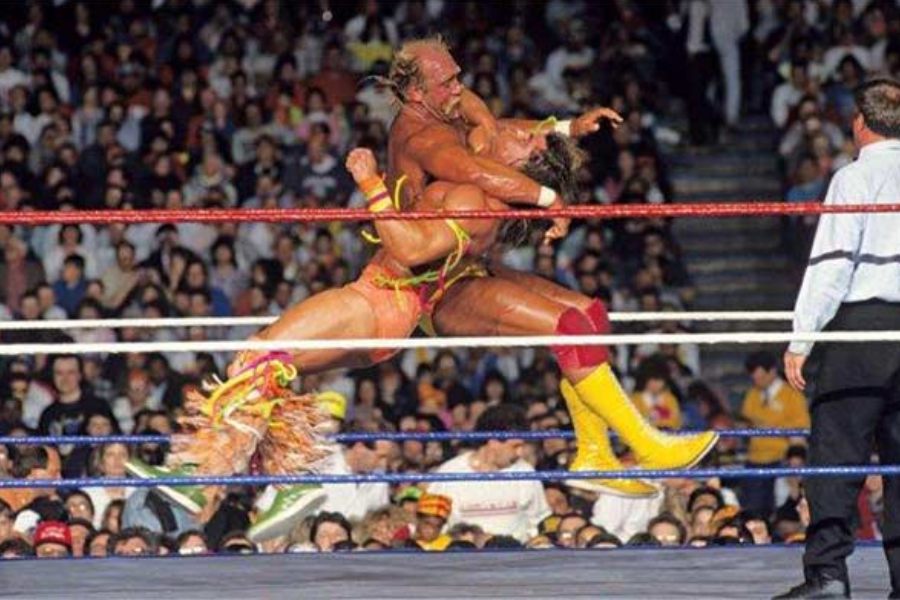The world of professional wrestling is filled with larger-than-life personalities, iconic rivalries, and signature moves that define the careers of its greatest stars. Among these legendary moments stands the Hogan DiBiase Atomic Drop, a move that not only became a defining aspect of the feud between Hulk Hogan and Ted DiBiase but also left an enduring mark on the wrestling industry. This powerful maneuver captivated fans and symbolized the intense, dramatic storytelling of 1980s and 1990s wrestling.
In this article, we will explore the history, technique, impact, and lasting legacy of the Hogan DiBiase Atomic Drop, and how it shaped one of the most memorable rivalries in wrestling history.
The History of the Hogan DiBiase Atomic Drop
The atomic drop is a classic wrestling move that has been used by countless wrestlers over the years. Its origins can be traced back to the early days of professional wrestling, where grapplers employed the move as a simple but effective way to weaken their opponents. The atomic drop involves lifting an opponent into the air and dropping them tailbone-first onto the wrestler’s knee, creating a sharp and jarring impact.
Though the atomic drop was already part of wrestling’s move set, it was during the heated rivalry between Hulk Hogan and Ted DiBiase that the move gained widespread fame. Throughout the 1980s and early 1990s, Hogan and DiBiase were two of the most prominent figures in professional wrestling. Their feud captured the imaginations of fans, with each match between them becoming a must-see event.
Hogan, known for his strength and charisma, often used the atomic drop as a counter to DiBiase’s technical wrestling skills. DiBiase, the “Million Dollar Man,” played the perfect foil to Hogan’s all-American hero persona, and the atomic drop became a recurring symbol of Hogan’s physical dominance in their matches.
The Hogan DiBiase Atomic Drop quickly became one of the key moments fans anticipated, often serving as a turning point in their battles. The move, with DiBiase writhing in pain afterward, helped solidify the atomic drop’s place as one of the defining elements of their legendary rivalry.
The Technique of the Atomic Drop
While the atomic drop may seem straightforward, it requires a level of precision, strength, and coordination to execute correctly. Here’s a step-by-step breakdown of the technique behind this iconic move:
- Lifting the Opponent: The wrestler performing the atomic drop begins by standing face-to-face with their opponent. The wrestler then bends down, grips their opponent by the legs or waist, and hoists them into the air, typically with the opponent’s back facing the wrestler.
- Positioning: Once the opponent is elevated, the wrestler must position their own body carefully to ensure the move is executed cleanly. This often involves stepping forward slightly to angle their knee and prepare for the impact.
- The Drop: The wrestler then brings the opponent down, aiming to have the opponent’s tailbone land directly on the wrestler’s knee. The impact is designed to jolt the opponent’s lower spine, causing significant discomfort and incapacitating them temporarily.
- Timing and Impact: Timing is crucial when performing the atomic drop, as the move needs to look impactful without causing real injury. In the hands of a skilled performer like Hogan, the atomic drop became a visually stunning maneuver that often elicited loud reactions from the audience.
Though relatively simple compared to more modern high-flying moves, the atomic drop’s effectiveness lies in its realism. When done properly, it simulates a painful shock to the spine and pelvis, making it a dramatic moment in any match.
The Impact of the Hogan DiBiase Atomic Drop
The Hogan DiBiase Atomic Drop was more than just a wrestling move—it was a pivotal element of a legendary feud that defined an era of professional wrestling. The move’s popularity helped elevate it from a standard maneuver to a significant storytelling device that shaped the outcome of matches between these two wrestling icons.
Defining an Era
The 1980s and early 1990s were characterized by larger-than-life characters, dramatic storylines, and intense in-ring action. Hogan’s atomic drop on DiBiase became synonymous with this era, as fans eagerly awaited the moment when Hogan would deliver the move, knowing it often marked a shift in the match’s momentum. It symbolized the physicality and drama that made professional wrestling so appealing to fans at the time.
Influence on Other Wrestlers
Due to its simplicity and effectiveness, the atomic drop quickly became a move that other wrestlers adopted into their arsenals. While Hogan and DiBiase popularized it, many wrestlers from different promotions began to use variations of the atomic drop, contributing to its widespread use in wrestling matches throughout the 1980s and beyond.
Pop Culture Relevance
Hogan and DiBiase’s feud, and the atomic drop, were not only influential within the wrestling world but also became a part of pop culture. Wrestling during this period was firmly embedded in the public consciousness, and moments like the Hogan DiBiase Atomic Drop were featured in highlight reels, promotional material, and video games, further cementing its iconic status.
The Psychological Impact of the Atomic Drop
The Hogan DiBiase Atomic Drop wasn’t just a physical move—it carried significant psychological weight both for the wrestlers and the audience. Wrestling, at its core, is about storytelling, and this move played a crucial role in building tension and excitement in their matches.
Fan Anticipation
Every time Hogan prepared to deliver the atomic drop, fans in attendance and those watching at home knew something big was about to happen. This anticipation added to the drama, making the atomic drop a highly anticipated moment that could change the course of the match. The crowd would erupt as DiBiase was lifted into the air, knowing that the move often signaled Hogan’s comeback.
Power Dynamics
The atomic drop also represented the power dynamic between Hogan and DiBiase. Hogan, known for his larger-than-life persona, was often portrayed as the stronger, more resilient competitor, and the atomic drop served as a demonstration of that dominance. DiBiase, despite his technical prowess, would be left in agony after the move, reinforcing Hogan’s physical superiority.
Storytelling in the Ring
The pain inflicted by the atomic drop wasn’t just physical—it was a crucial part of the story being told in the ring. DiBiase’s reactions to the move allowed Hogan to garner sympathy from the crowd, further intensifying the rivalry. The move was often a key moment in their matches, leading to dramatic shifts in momentum and building toward the climax of the bout.
The Legacy of the Hogan DiBiase Atomic Drop
Though professional wrestling has evolved over the years, the legacy of the Hogan DiBiase Atomic Drop continues to be felt. The move remains a respected part of wrestling history, particularly for its role in one of the most memorable rivalries of all time.
Influence on Modern Wrestlers
Many modern wrestlers continue to use variations of the atomic drop in their matches, paying homage to the legends who helped popularize the move. While today’s wrestling landscape features faster, more acrobatic maneuvers, the atomic drop remains an effective tool for delivering pain and building drama.
Defining Careers
For both Hogan and DiBiase, the atomic drop played an integral role in their wrestling careers. It helped define their in-ring personas and contributed to the intensity of their rivalry. The move, much like the wrestlers themselves, has become a part of wrestling’s rich history, symbolizing the physical and emotional intensity of their feud.
The Atomic Drop in Modern Wrestling
While the atomic drop may not be as prevalent in modern wrestling, it still holds its place as a classic maneuver. Wrestlers today often incorporate variations of the move to adapt it to their own style, using it as a transitional move or as a setup for more elaborate finishing maneuvers.
Variations of the Atomic Drop
In modern wrestling, some wrestlers have modified the atomic drop to make it more impactful, adding their own spin to the classic move. This could involve higher elevation, faster execution, or integrating the move into a sequence of other attacks.
Effectiveness Today
Despite the evolution of wrestling into a more fast-paced and acrobatic sport, the atomic drop remains a move that, when used properly, can still elicit a strong reaction from the audience. Its simplicity allows it to fit seamlessly into various wrestling styles, making it a versatile tool for wrestlers looking to build drama and deliver a memorable performance.
Conclusion
The Hogan DiBiase Atomic Drop stands as a testament to the art of storytelling in professional wrestling. More than just a physical move, it embodied the intense rivalry between two of wrestling’s greatest stars and became a symbol of the golden age of wrestling. Its legacy continues to inspire new generations of wrestlers, reminding us that the best moments in wrestling are often the simplest, yet most impactful.
For fans of professional wrestling, the Hogan DiBiase Atomic Drop will forever remain an iconic and celebrated part of the sport’s history.
FAQs
1. What is the Hogan DiBiase Atomic Drop?
The Hogan DiBiase Atomic Drop is a wrestling move where Hulk Hogan would lift Ted DiBiase and drop him tailbone-first onto his knee, causing significant pain and shifting the momentum in their matches.
2. How did the Hogan DiBiase Atomic Drop become iconic?
The atomic drop became iconic due to its frequent use in the rivalry between Hulk Hogan and Ted DiBiase, adding drama and intensity to their bouts.
3. What are the risks associated with performing the atomic drop?
While relatively safe, improper execution of the atomic drop can lead to back or pelvic injuries, making timing and positioning critical.
4. How has the Hogan DiBiase Atomic Drop influenced modern wrestling?
Many modern wrestlers have adopted variations of the atomic drop into their repertoires, paying homage to its legacy while adapting it to contemporary wrestling styles.
5. Is the atomic drop still used in wrestling today?
Yes, while less common, the atomic drop is still used in modern wrestling, often as part of a sequence or as a transition move in matches.
“Stay informed with exclusive features and breaking news at Tribunexpress.com.”




